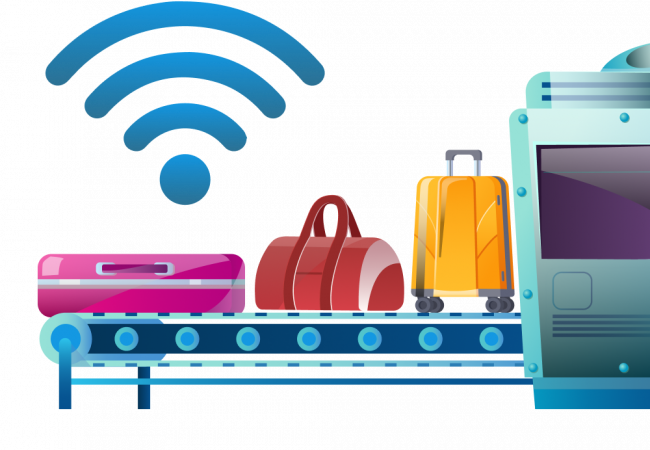Baggage Handling and IOT
Baggage Handling and IOT

Why IOT in Baggage Handling?
The “Internet of things” (IoT) is becoming an increasingly growing topic of conversation both in the workplace and outside of it. The Internet of things (IoT) is the internetworking of physical devices, vehicles (also referred to as “connected devices” and “smart devices”), buildings, and other items—embedded with electronics, software, sensors, actuators, and network connectivity that enable these objects to collect and exchange data. This nifty combination of devices allows you to track your bags throughout the journey directly on your smartphone using GSM, GPS and Bluetooth technology. The system automatically updates and displays flight details and a barcode when you check-in online from home. All you have to do is drop off the bag at the terminal and go.
Further IOT is used in RFID Technology to track baggage. Radio-frequency identification (RFID) uses electromagnetic fields to automatically identify and track tags attached to objects. The tags contain electronically stored information. a RFID system consists mainly of three components; the transponder/tag, reader, and RFID middleware. This automatic data capture technology that relies on radio-frequency electromagnetic fields. Hence the name, Radio-Frequency IDentification or RFID.
Why The Topic?
Well I came across certain statistics that led me to explore the topic and possible solution architectures to implement this solution as follows:
- Having plateaued between 2018 and 2019, the number of mishandled bags dropped to 3.5 bags per thousand passengers in 2020. Investments in technology for airports to support their airline and ground handler tenants continue to reduce the number of mishandled bags and their associated costs while providing a cost-effective way for airlines to comply with IATA’s baggage tracking Resolution 753.
- After reaching a high of 4.54 billion passengers in 2019, the COVID-19 pandemic caused 2020 passenger numbers to drop to 1.8 billion, the lowest since SITA began reporting passenger trends in 2007
- Airports and airlines are speeding up investments in touchless self-service processes to make the journey through the airport safer and more efficient for passengers and staff.
- Between 2007 and 2020, the mishandling rate per thousand passengers has reduced by 81%, from 18.88 bags to 3.5 bags.The air transport industry’s annual bill for mishandled bags was $600 million in 2020, an 85% decrease from $4.2 billion in 2007.
- There was a rise in mishandling as a result of failure to load (20% in 2020); an increase from ticketing errors, bag switches, security, and other miscellaneous factors (19%); and a slight increase from airport, customs, weather, or space-weight restrictions (10%) and tagging errors (6%).
Hence according to SITA, though baggage handling has improved, the following issues still plague the Airline Operations:
- Transfer Mishandling
- Ticketing error/Bag switch/ Security/Other
- Loading error
- Arrival mishandling
- Airport/Customs/Weather/Space-weight restriction
- Failure to load
- Tagging error

“Hence we see that the most common Loop holes experienced in Aviation industry for Baggage Handling are mislaid baggage, lost baggage and damage to belongings. So, for providing a better and secure system to the passengers, we believe the design of baggage tracing and handling system using smart RFID tags and IoT which is based on cloud server can be pivotal and instrumental in ensuring a low fault Baggage Handling Ecosystem. Lets dig further to understand how this system will work.”
RFID Technology Overview and Components Overview
This means that the travel and tourism agencies would have to adopt some radical measures to tackle the current crisis in travel and tourism agencies. Some of our educated suggestions are as follows :
Radio-Frequency IDentification or RFID. This technology can be used in our daily lives and objects so that they transit from manufacture to storage and finally the point of sale. The difference between objects and ourselves is that they don’t “voluntarily” present their RFID tag or card when asked. The data in these cards can be sensed by the localised tag readers. These tags are therefore read in very different conditions and often require greater detection distances.

RFID Technology Overview and Components Overview
This means that the travel and tourism agencies would have to adopt some radical measures to tackle the current crisis in travel and tourism agencies. Some of our educated suggestions are as follows :
Radio-Frequency IDentification or RFID. This technology can be used in our daily lives and objects so that they transit from manufacture to storage and finally the point of sale. The difference between objects and ourselves is that they don’t “voluntarily” present their RFID tag or card when asked. The data in these cards can be sensed by the localised tag readers. These tags are therefore read in very different conditions and often require greater detection distances.
There are tags which manage RFID Technology and provide data via the tag readers. The tags can be classified via the following categories :
01 Passive Battery :
Battery needed, the tags contain electronically stored information. Passive tags collect energy from a nearby RFID reader’s interrogating radio waves.
02 Active Battery:
Active tags have a local power source such as a battery and may operate at hundreds of meters from the RFID reader. RFID tags contain at least two parts: an integrated circuit for storing and processing information, modulating and demodulating a radiofrequency (RF) signal, collecting DC power from the incident reader signal, and other specialized functions; and an antenna for receiving and transmitting the signal
03 Reader:
An RFID reader transmits an encoded radio signal to interrogate the tag. The RFID tag receives the message and then responds with its identification and other information. This may be only a unique tag serial number, or may be product-related information such as a stock number, lot or batch number, production date, or other specific information. Since tags have individual serial numbers, the RFID system design can discriminate among several tags that might be within the range of the RFID reader and read them simultaneously.
Proposed Solution For IOT Based Baggage Handling
Information Capture
At check-in section, the information of each and every passenger is taken and stored in information bank (server). The information bank consists of four important items including the name of the Airline, flight number, bag nature and mobile number of the passenger along with the identification number which is peculiar to each person. This identification number is stored in the memory of the RFID tag along with the other details of the passenger for any further investigation and referral to the information about the person and their luggage. The same identification number is sent to the passenger through SMS in order to keep it personal.
Baggage Handling System
After the making of tags and sticking them on baggage, it is passed through a gate including four RFID readers. All the baggage is passed through EDS (Electronic Data System) to observe their content and sort them according to their flight number. The baggage is then loaded to the respective flights and for conforming that the baggage is being loaded on the flight, baggage is again passed through RFID readers at the time of loading and the information is stored at the local server.
Baggage Sorting
After the passengers arrive at their destination and the baggage is ready for offloading they are passed through the RFID readers, the Identification number of the tags read by the readers are stored in the local Server of Destination Airport, which confirms the offloading of baggage at the destination Airport. The baggage is passed through a gate including four RFID readers on the conveyer belt and simultaneously will inform the passenger that the baggage is arrived at the airport through SMS.
Baggage Detection and Passenger Interface
When the passenger reaches the counter he will have to enter the unique identification number received by him on his mobile on the keyboard installed at the counter gate. Now, the identification number is read by the reader they will try to match the information related to the Identification number on the RFID tag and entered by the passenger , which was already uploaded on the main cloud server by the Arrival Airport. Further the process of sorting will occur. As soon as the entered identification number is read by the reader the push mechanism will sort the bag to the required counter by opening the gate controlled by servo motor and the confirmation message about passenger receiving the baggage will send the message to the Server
Technology Implementation Overview
When the passengers arrived at the location 1 their basic information like number of bags, their mobile number, the serial number (s) of RFID attached at each bag, destination, identification code was stored on a local sever. The information about passengers was stored on local server and was uploaded to a cloud in which the server’s of location 2 is connected with the help of IoT. When the baggage was ready to be loaded on airplane it was passed through RFID readers, the readers read that particular serial number and sent it to the Raspberry Pi via Ethernet; Raspberry Pi sends it to local server which will note that the baggage was loaded.
After the passengers arrived at their destination (location 2) their baggage was loaded on the conveyer belt, which will keep on rotating the baggage until someone calls for it. The passengers will receive a unique identification code when they give their luggage during boarding which will be sent in the form of SMS. passenger enters his identification code the identification code will go to server where it will check the number of baggage and their serial number under that identification number entered by passenger, the serial number (s) will then be sent to the reader and the reader will sort out the bags of that serial numbers accordingly. When the serial number(s) of the baggage is detected by reader the servo motor opens the gate and a push mechanism installed on conveyer belt pushes the baggage out of the gate, this functioning will be achieved with the help of Arduino.
The Implementation Platforms Are As Follows :
- RFID Components- RFID tags, RFID readers, backend software interface
- Arduino kit and software
- Readers connected via Ethernet
- Cloud-based server
- SMS Gateway
Benefits Of The Proposed Solution :
- RFID technology can be used for tracking products or product identification
- Does not require line of sight to read the tag
- Has a longer read range than barcode reader
- Tags can store more data than bar codes
- Readers can simultaneously communicate with multiple tags

The Implementation Platforms Are As Follows :
- RFID Components- RFID tags, RFID readers, backend software interface
- Arduino kit and software
- Readers connected via Ethernet
- Cloud-based server
- SMS Gateway
Benefits Of The Proposed Solution :
- RFID technology can be used for tracking products or product identification
- Does not require line of sight to read the tag
- Has a longer read range than barcode reader
- Tags can store more data than bar codes
- Readers can simultaneously communicate with multiple tags
Conclusion
In this solution, passenger could get better security, reduce baggage loss and mishandling to a great extent and every baggage will be delivered on time. And because of the counters created, passengers got distributed into groups which will also decrease the time consumed at check-out. The main advantage of the system is that it consumes less time as the passengers don’t have to wait for their baggage to turn up on the conveyer belt instead they are routed to different counters and ensures high security due to the unique identification number. It is following the current trend as it is environment friendly, as it is paperless, no printing and paper are needed which is a very important issue currently in the aviation industry. With this design we tend to make the air travel more customers friendly, less time consuming, hassle free, with less queuing and greater security of the passenger
Have an Inquiry?

Sunil P
Sunil is an avid Web 3.0 technology evangelist and heads the front end practice at AARCHIK Solutions







